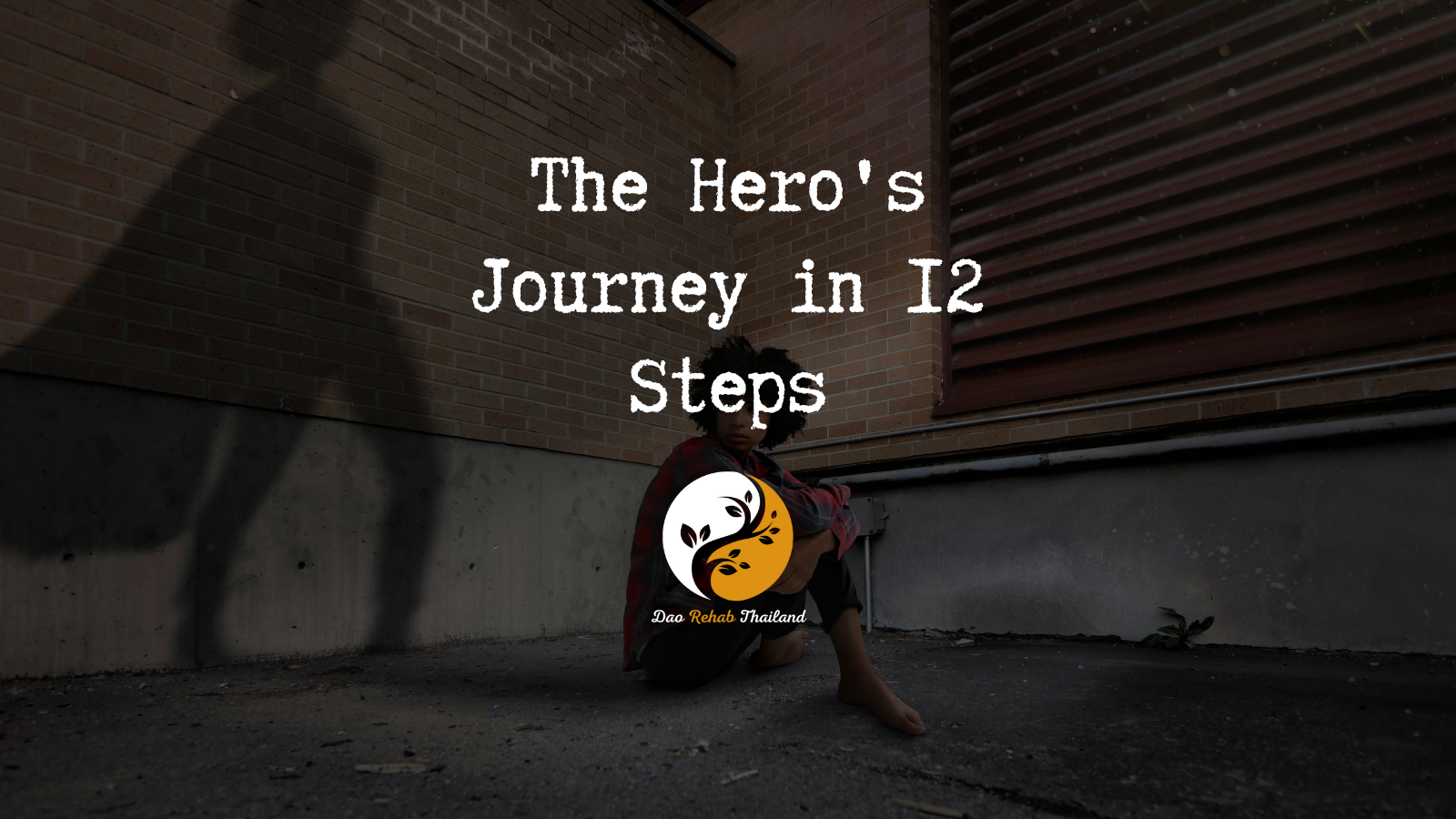
The Hero’s Journey in 12 Steps
The Hero's Journey
in 12 Steps
“Turning the impossible into possible”

"Detox from Drugs at a Luxury Holistic Center in Thailand and Israel"

Dr. Mizrahi Avraham on the teachings of Carl Jung and Bill Wilson
The Hero’s Journey is a basic narrative structure that has appeared in many works throughout human history. It is a practical version of the 12-step model, based on the groundbreaking work of Bill Wilson, founder of Alcoholics Anonymous. This structure reflects not only the external journey of a character in a story, but also the deep internal processes of development, coping, and change that each of us goes through throughout our lives.
"Holistic Center for Trauma, Addiction, and Mental Imbalance Treatment in Thailand"
“Come to the beginning of your journey to freedom from addiction to alcohol, drugs, and pills, and rediscover your life within the serene embrace of DaoTherapy Rehab in Thailand—where holistic healing meets empowering recovery.”
DaoTherapy Holistic Rehab
Key Elements of Drugs Detox:
Medical Supervision: Drugs detox must be conducted under medical supervision, as the body may experience withdrawal symptoms. These can include nausea, anxiety, muscle aches, and insomnia. A medical team will monitor and manage these symptoms to ensure the patient’s safety and comfort.
Holistic Therapies:
Holistic Therapies: Many detox programs incorporate holistic therapies such as mindfulness, yoga, and meditation to help individuals cope with stress and anxiety during the detox process. These therapies support the mind-body connection and contribute to overall recovery.
Tapering Process
Tapering Process: Drugs detox often involves a gradual tapering of the drug to reduce withdrawal severity. Doctors will slowly decrease the dosage over time to allow the body to adjust to lower levels of the substance.
Psychological Support:
Psychological Support: Like any addiction recovery process, detox from Drugs includes psychological support. This can involve counseling, therapy, or support groups to address the mental and emotional aspects of addiction.
Post-Detox Treatment:
Post-Detox Treatment: After completing detox, continuing treatment is crucial to prevent relapse. This often includes participation in ongoing therapy, group support, and the development of new coping strategies to maintain sobriety.
The story begins in the "ordinary world", where the protagonist and his familiar surroundings are introduced.
The story begins in the “ordinary world,” where the hero and his familiar surroundings are introduced. This is the starting situation, from which the journey begins. Next comes the “call to adventure” – a challenge or problem that invites the hero to leave his comfort zone and begin a process of change. There will usually be initial resistance, a “refusal to call,” which reflects the natural human fear of the unknown.
To overcome fear, the hero meets a “mentor” figure – a wiser and more experienced guide, who provides advice, knowledge, or tools to help on the journey. With the mentor’s encouragement, the hero crosses a threshold and moves into the “special world,” an unfamiliar and challenging space where most of the story will take place. There, he meets allies and enemies, and undergoes tests that build his character and abilities in preparation for the great challenge.
The climax of the story comes in the “ultimate test,” in which the hero confronts his deepest fear. This is a moment of symbolic “death” and rebirth, from which he emerges a new and different person. Success in the test earns the hero a “prize,” a powerful insight or ability he didn’t have before. But the story doesn’t end there—the hero must return from the journey and bring his gift to the ordinary world. The true hero uses the knowledge he has acquired to help and benefit his community.
The power of the hero’s journey lies in our ability to project ourselves onto the story and see in it a reflection of the struggles and processes in real life. Each of us is the hero in our own life story, repeatedly confronting challenges and fears, learning about ourselves, changing, and growing. In this sense, the 12 stages of the journey constitute a kind of roadmap for development, reminding us that difficulties are an integral part of the path, and that the power to overcome them lies within us.
This pattern can also help us as creators and storytellers. By consciously using the different stages, we can build fascinating plots and relatable characters that reflect something universal in the human experience. This creates an empowering viewing or reading experience that illuminates life with new meaning and motivates us to look within ourselves.
The Hero’s Journey is much more than just a formula for writing successful stories. It is a masterful template for life itself – a way to look at challenges as opportunities for growth, to be inspired by stories of overcoming, and to discover the hero hidden within each of us. It is an opening for an ongoing internal dialogue, in which we try to understand the meaning of our personal journey and our place in the greater human story.
Through this perspective, every crisis is a call to adventure, every mentor is a gift, every failure is a lesson. We are the authors of our lives, wandering into the unknown with courage and curiosity. We have the power to rewrite our personal story, and shape it in the image of our highest dreams and aspirations. When we learn to recognize the beauty and power inherent in this path, we can live life like a masterpiece – a true heroic journey, moment by moment, chapter by chapter.

contact us
Contact us with your questions
We would love to speak with you! Feel free to reach out with any questions.

get in touch
Schedule a free consultation
Schedule a free consultation with our team and let’s make things happen!
The 12 Stages of the Hero's Journey
1.The Ordinary World
The hero’s journey is a narrative structure that describes the main character’s internal and external journey. Screenwriting expert Christopher Vogler developed a shortened 12-step version based on the work of Joseph Campbell. The first stage is “the ordinary world,” where the main character is presented in his or her natural environment. This is the time to introduce the character, their world, and their typical behaviors. This stage should also hint at the conflict or mission that the hero will face later.
2. The Call to Adventure
The second stage comes with the “call to adventure”—the announcement of a problem to be solved or a wish to be fulfilled. This is what creates energy in the story and grabs the audience’s attention. We are programmed to identify with the characters’ wants and needs, even if they are simple cartoon characters. Therefore, this stage is an opportunity to state the hero’s motivation in a way that will arouse empathy and curiosity.
3. Refusal to Read
The third stage is usually “refusal to read”. Most heroes first express resistance to the task or adventure that is offered to them. They may claim that they do not want or are unable to go on a journey, or have already done it in the past and the experience was not pleasant. This stage is designed to emphasize to the audience that the expected journey is scary and dangerous. Even determined heroes may provoke reactions such as “Don’t go, it’s too dangerous!”. This fear is necessary to create tension and emotional involvement in the audience.
4. Meeting the Mentor
To overcome fear, the fourth stage comes, “meeting the mentor”. The mentor is a wise and experienced character who has gone through the hero’s journey many times. His main role is to give the hero encouragement, advice, or resources that will help him on his journey. The mentor can provide knowledge, a map, a magical object, or simply a promise that the challenges of the new world can be survived. This stage helps the hero feel secure, but the absence of a mentor can create special tension and signal that this is a different story than usual.
5. Crossing the Threshold
The fifth stage is “crossing the threshold.” This is a crucial moment when the hero, having equipped himself with the necessary knowledge and tools, finally sets out on a journey and enters the special world. The common comparison is to an airplane taking off and rising into the air. This is a significant turning point in the story, often accompanied by a change in music or a new energy in the scene. It is a clear message to the audience that the hero is leaving Kansas and arriving in a completely exotic and different place.
6. Trials, Allies, and Enemies
In the sixth stage, “Trials, Allies, and Enemies,” the hero begins to get to know the new world. He goes through relatively small tests and challenges, designed to test his skills and make it clear to him that he doesn’t know the rules of the game. The hero must quickly figure out who can help him and who might hinder him. This is a stage where alliances are built, like in the cantina scene in “Star Wars,” and it is revealed that the new world is full of strange creatures and surprising violence.
The 12 Stages of the Hero's Journey
7. The Approach
The seventh stage is the “Approach”—a period of time in which the protagonist slowly moves toward the heart of the story. During this journey, the protagonist and the rest of the group become more familiar with each other. Initial impressions change, friendships strengthen or weaken, and suspicion and paranoia may develop. This is a time for comedy, romance, and subplots that deepen the characters’ understanding of the central challenge. In preparation for the climax of the story, this stage is like loosening the belt a little and going deeper.
8. The Supreme Test
The eighth stage is the heart of the story—the “Supreme Test.” It consists of two parts: facing death (or a near-death experience), and the rebirth that grows out of it. Sometimes these two parts span two scenes, and sometimes they occur in one scene. Physical fights, legal battles, difficult family arguments – intense confrontations in which it seems that something is going to die are common at this stage. In many myths, the hero does die and is reincarnated into another reality, from the perspective of the ordinary world he is gone. But the hero is given a second chance, and returns from the difficult test changed and improved – the old self has died and crumbled, and in its place something new is born. This is often a surprise to both the hero and the audience, a profound insight that it is possible to survive and face the greatest fear.
9. The Reward – The Gifts Along the Way
The ninth stage is called “the reward”, and it is about reaping the fruits of the supreme test. This is a time for reflection on the shattering experience, for reassembling the identity and experimenting with the newly born self. The hero looks in the mirror, ponders the events, and realizes that he is capable of more than he thought – he can dream big and act in new ways. Sometimes this is expressed in a long, profound speech in which the hero reveals his insights. An atmosphere of celebration and reward accompanies this stage, but at some point one must pull oneself together and focus on completing the mission.
10. The Road Home
In the tenth stage, “The Road Home,” there is an acceleration of energy and urgency. The heroes realize that they must hurry to get ahead of the villains and claim victory before it is too late. If the treasure is stolen or a loved one is kidnapped, a desperate chase begins. Chase scenes are very common at this stage in Hollywood films. Home is already in sight, but dangers and plot twists still lurk that could trip up the heroes.
11. The Hero’s Resurrection
The eleventh stage, “The Hero’s Resurrection,” is the decisive climax of the plot. This is where all the questions arise and here the hero answers them through one decisive choice or one significant action. This is the time to finally confront the villains, to seize the legacy, to stand a final test. The hero must put everything he has learned on the line to succeed here – this is the final exam that must not be failed. If the hero faces his final fears, draws on the lessons he has learned on the journey, and trusts in all the abilities he has acquired, he will ultimately be able to overcome at the last moment, against all odds, in a surprising and satisfying move that will defeat the dark forces and complete the profound process he has gone through.
12. Return with the Potion
The final stage of the hero’s journey is called “return with the potion.” After going through such a formative and life-changing experience, the hero has a commitment, and sometimes even a deep desire, to share it with everyone. This is what makes him a true hero according to Campbell’s definition – someone who protects and serves the common good, and does not act out of selfishness. A good hero ultimately sacrifices something precious to him in order to contribute to the community. There is a sense of expansion here – the small world and the personal needs of the hero suddenly take on a broader meaning. The lesson learned through the difficult struggle becomes a story to be told, a new idea to be spread, a love to be shared. This elixir is like a magic potion that has the power to heal wounds and solve problems, and the hero’s job is to carry it back into the world.
The 12 stages of the hero’s journey are a magical recipe for creating moving and inspiring stories. By understanding this deep structure, and including it in a work in a conscious and focused way, you can touch the hearts of your audience, make them feel deep things, and maybe even slightly change their worldview. When you follow this pattern and develop it properly, a story can expand the sense of possibility and give viewers an unforgettable experience.
Central insights
1. The hero’s journey is a universal pattern that appears in many stories and reflects the inner journey of each of us.
2. Every story begins by presenting the hero’s “ordinary world,” which represents the existing situation from which the hero embarks on the journey.
3. The “call to adventure” symbolizes the need for change or the challenge that the hero must face.
4. The hero’s initial fear and refusal are a necessary part of the process, signaling to the audience that the journey will be challenging and meaningful.
5. The mentor is a key figure who guides the hero and provides him with advice, knowledge, or tools essential for success.
6. Crossing the threshold represents the hero’s entry into a new and unfamiliar world, where he will face challenges and changes.
7. In the special world, the hero undergoes tests, finds allies, and encounters enemies, a process that shapes his character and abilities.
8. The climax of the story is the hero’s confrontation with his greatest fear, his symbolic “death” and rebirth.
9. After the decisive confrontation, the hero wins a “prize” – a profound insight or new ability that changes him forever.
10. The true hero always returns to share the gift or knowledge he has acquired with the community, to benefit others and spread goodness.
practical advice:
1. Don’t be afraid to step out of your comfort zone and face challenges – it’s essential for growth and development.
2. Seek out mentors and guides who can guide and support you along your personal journey.
3. Be open to new experiences and the possibility that you may need to change to achieve your goals.
4. Don’t give up when you encounter obstacles or enemies – dealing with them will ultimately strengthen and empower you.
5. Remember that failures and difficult moments are an integral part of the journey, and through them you can learn and improve.
6. When you gain a significant insight or achievement, share it with others to increase good in the world.
Psychological Support:
Psychological Support: Like any addiction recovery process, detox from Subutex includes psychological support. This can involve counseling, therapy, or support groups to address the mental and emotional aspects of addiction.
Thought provoking questions:
1. Can you identify moments in your life journey that parallel the stages described in the chapter on “The Hero’s Journey”?
2. What challenges or obstacles are you currently avoiding facing due to fear or uncertainty? How could you overcome them?
3. Who are the mentors who have helped you at crucial moments in life and given you important knowledge or encouragement?
4. What “gift” or valuable insight would you like to share with others to positively impact the world, following your significant experiences?
5. Which of the “Hero’s Journey” insights in this chapter resonate with you the most, and how do you intend to apply them to move forward toward your personal goals?








